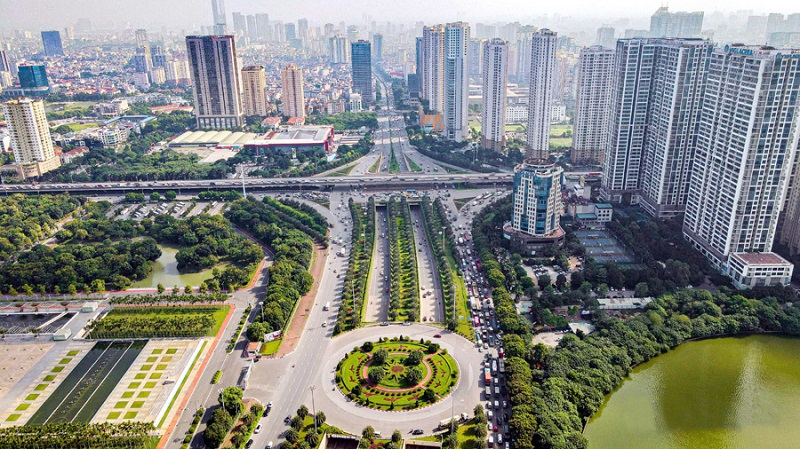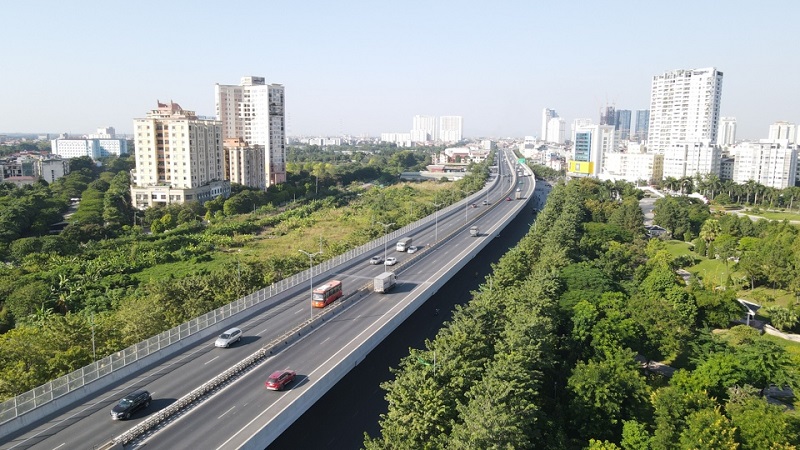
On the morning of October 10, 1954, soldiers of the 308th Division - the "Vanguard Division" - marched into Hanoi to take the capital after nine long years of resistance.
| View of Thang Long Boulevard from above. Photo: Hoang Ha/The Hanoi Times |
From a small town with the Old Quarter as its core, Hanoi has made great strides over the past 70 years, transforming itself into a sprawling metropolis with extensive infrastructure.
Hanoi's administrative boundaries were expanded in 2008, bringing its total area to 3,359 square kilometers. Business operations, freight transport and commuting were hampered by the city's then-inadequate connectivity and infrastructure.
Hanoi has been transformed into a modern city with an extensive, large-scale transport infrastructure. Major thoroughfares and connecting roads have facilitated travel throughout the city's districts and beyond.
As one of the country's two most populous cities, with a population of nearly 10 million, Hanoi faces a high demand for transport, commerce and the movement of goods. Traffic congestion is a common problem due to the high density and volume of vehicles, while infrastructure continues to lag behind rapid population growth.
In recent years, Hanoi's transport system has undergone significant development, with major investments in highways, expressways and large-scale projects totaling hundreds of trillions of dong.
The city has invested heavily in developing and upgrading its public transportation system, including buses, Bus Rapid Transit (BRT), and metro lines.
The Cat Linh-Ha Dong and Nhon-Hanoi elevated railway projects are now operational after years of construction, marking an important step in reducing traffic congestion and improving mobility for citizens. The bus network has been expanded and modernized with new routes and environmentally friendly electric buses.
Hanoi has also focused on expanding roads and building flyovers, underpasses, and smart intersections to alleviate congestion. Urban transport planning projects are being implemented in a synchronized manner to create an efficient and sustainable network.
These achievements are the result of strong leadership from the central and local governments, as well as the concerted efforts of the departments, districts and agencies involved," said Nguyen Phi Thuong, Director of the Hanoi Department of Transportation.
While road construction has a significant impact on the lives of residents, compensation and site clearance issues affect the timeline of many projects, he said, adding that the recently passed Land and Capital Laws are expected to address these challenges.
Advances in transportation have improved traffic flow and quality of life, created favorable conditions for economic development, and attracted investment to the city. Hanoi is now a modern city that meets the growing demands of residents and tourists alike.
Today, Hanoi has numerous arterial roads that seamlessly connect with highways leading to various provinces and regions. Major roads such as Ring Road No. 4, which is expected to be completed by 2027, will improve connectivity.
These highways, such as National Highway No. 5 and the Hanoi-Hai Phong Expressway (to the east and northeast), Hanoi-Lao Cai, Hanoi-Thai Nguyen and Lang-Hoa Lac (to the north and northwest), and Phap Van-Cau Gie Expressway and National Highway 1A (to the Red River Delta and southern provinces), strengthen Hanoi's connections with other northern provinces and cities.
Hanoi is also accessible by the North-South Railway and numerous waterways on major rivers. In particular, the Noi Bai International Airport facilitates trade and transportation with hundreds of countries.
A future of transportation breakthroughs
Infrastructure investment, especially the expansion of roads, bridges, and metro systems, is essential to alleviate current congestion on major routes, said Thuong, Director of Hanoi's Department of Transportation.
| Ring Road No.3 connects the central districts to the northern side of Hanoi. Photo: Hai Linh/The Hanoi Times |
Expanding the mass transit network is crucial, with a focus on improving service quality, increasing frequency and reducing fares to encourage the use of buses and subways, he said.
In addition, intelligent traffic management measures such as automatic traffic lights, surveillance cameras and IT applications have been used to effectively monitor and manage traffic, he said.
Raising public awareness about environmentally friendly modes of transportation, such as cycling and walking, is crucial to reducing traffic congestion and pollution, Thuong added.
The city's transportation development is a top concern for the Politburo, the National Assembly, and the government, with several directives providing a long-term vision.
The Politburo has issued three key resolutions: Resolution 15 on Capital Development Tasks, Resolution 06 on Vietnam's Sustainable Urban Planning, and Resolution 30 on the Socio-economic Development and Security of the Red River Delta, all of which set targets for 2030 and a vision for 2045.
The Prime Minister has also approved numerous projects related to roads, railways, waterways and airways, as well as the transportation planning of Hanoi's eight neighboring provinces.
Hanoi itself is conducting large-scale assessments and surveys, holding orientation conferences for 30 districts, holding thematic meetings, and organizing inter-regional conferences with the eight neighboring provinces to harmonize connectivity strategies.
Among the latest developments, Hanoi is exploring the construction of two sub-municipal cities, one in the north (covering the areas of Dong Anh, Me Linh and Soc Son districts) and the other in the west (covering the areas of Hoa Lac satellite city and Xuan Mai city), as well as five new urban corridors: the Red River corridor, the West Lake-Ba Vi corridor, the West Lake-Co Loa corridor, the Nhat Tan-Noi Bai corridor and the Southern corridor.
Hanoi's population is projected to reach 9.2 million by 2030, 12.5 million by 2045, and 14.6 million by 2065. The capacity of Noi Bai airport is planned to expand from 50 million passengers per year to 100 million by 2050, with a second airport in the south to accommodate an additional 30 million passengers per year.
Transit-oriented development (TOD) will serve as the foundation of Hanoi's planning strategy. Hanoi Railway Station is expected to be handed over to the city and designated as the central hub of the city's rail network.








